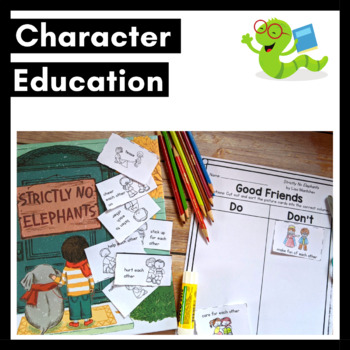Picture Book Companion - Strictly No Elephants Integrated Book Unit with STEM
Meredith Anderson - Momgineer STEM Activities
14.7k Followers
Grade Levels
K - 2nd, Homeschool
Subjects
Resource Type
Standards
CCSSK.CC.B.5
CCSS1.NBT.A.1
CCSS1.NBT.B.2
CCSS1.NBT.C.4
CCSS2.NBT.A.1
Formats Included
- PDF
Pages
130 pages
Meredith Anderson - Momgineer STEM Activities
14.7k Followers
Description
This is an integrated book unit that is not only standards-aligned, but differentiated to meet multiple levels of student learning. What better way to meet all your learning standards than through beloved children's picture books! With so many activities to choose from, you will have all the resources you need to dive into this book as deeply as desired.
This resource was developed to pair with the book Strictly No Elephants by Lisa Mantchev.
Contents
- Planning guide with suggested activities list.
- Differentiated ELA activities to explore the basics such as title, characters, main idea.
- Differentiated ELA activities that go deeper: reading comprehension, vocabulary, and writing.
- ELA graphic organizers that can be used as needed with ANY text.
- Differentiated math activities that are themed to complement the text.
- STEM challenges that are inspired by the read aloud: choose one of three provided or work through all of them.
- Unplugged coding activities to give students the foundations of computer programming. Tech is not required!
- Science activity inspired by the book.
- Craftivity - bring the story alive and practice skills such as coloring, cutting, and folding.
- Just for fun activities are also included - can be used with a sub, for early finishers, or while you are doing small group instruction with others.
Details on this resource (linked resources can be purchased independently if preferred)
- ELA activities: reading comprehension, vocabulary, idioms, synonyms and antonyms, actions and reactions (character education), character traits, comparing and contrasting main characters, word search puzzle. (13 pages)
- Character education: what do good friends do, what are things that good friends don't do? Introduction of positive intent also included.
- Math activities: print and go secret picture tiles (print version only)! Solve the problems, cut and paste on the correct square, and reveal the secret picture. (15 pages) plus measurement activities (3 pages).
- STEM challenges: 3 STEM activities to go with the book, using materials you have on hand, such as recyclables, math manipulatives, or building blocks. Includes a variety of recording sheet options, such as graphic organizers or guided STEM challenge pages, plus self-evaluation/rubric. (15 pages)
- Unplugged coding and technology: 3 levels of unplugged coding with directional coding and conditional statements (color and black and white, 6 pages) plus story unplugged coding. Technology activity suggestions (8 pages).
- Science: Learn about elephants and explore chemical reactions with elephant toothpaste. (3 pages)
- Craftivity: 3D paper animals. Use alone or with the STEM activity. (3 pages)
- Just for Fun: Spot the differences and complete a symmetric drawing are included (6 pages).
- Graphic Organizers: ELA graphic organizers for use with any text (20 pages)
Who can use Bookshelf STEM Junior?
- K-2 classroom teachers
- STEM specials teachers
- Librarians
- Makerspace facilitators
- Homeschool parents
- Community group leaders such as girl scouts, cub scouts, and 4H
- Camp counselors - make your summer or school vacation camp a literacy-filled affair
Total Pages
130 pages
Answer Key
Included
Teaching Duration
N/A
Report this resource to TPT
Reported resources will be reviewed by our team. Report this resource to let us know if this resource violates TPT’s content guidelines.
Standards
to see state-specific standards (only available in the US).
CCSSK.CC.B.5
Count to answer “how many?” questions about as many as 20 things arranged in a line, a rectangular array, or a circle, or as many as 10 things in a scattered configuration; given a number from 1-20, count out that many objects.
CCSS1.NBT.A.1
Count to 120, starting at any number less than 120. In this range, read and write numerals and represent a number of objects with a written numeral.
CCSS1.NBT.B.2
Understand that the two digits of a two-digit number represent amounts of tens and ones. Understand the following as special cases:
CCSS1.NBT.C.4
Add within 100, including adding a two-digit number and a one-digit number, and adding a two-digit number and a multiple of 10, using concrete models or drawings and strategies based on place value, properties of operations, and/or the relationship between addition and subtraction; relate the strategy to a written method and explain the reasoning used. Understand that in adding two-digit numbers, one adds tens and tens, ones and ones; and sometimes it is necessary to compose a ten.
CCSS2.NBT.A.1
Understand that the three digits of a three-digit number represent amounts of hundreds, tens, and ones; e.g., 706 equals 7 hundreds, 0 tens, and 6 ones. Understand the following as special cases:





